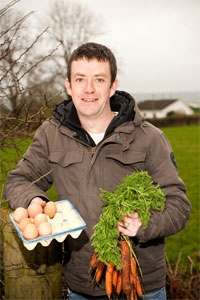Grow it Yourself - December
 I have started to harvest celeriac from the garden now – it’s a hardy veg that I generally leave in the ground until things are starting to get a bit sparse elsewhere and when most of the celery is gone.
I have started to harvest celeriac from the garden now – it’s a hardy veg that I generally leave in the ground until things are starting to get a bit sparse elsewhere and when most of the celery is gone.
I am a huge fan of celeriac – it has all the lovely smooth flavour of celery, but with the added benefit that it stores exceptionally well. It will keep for up to four months if stored correctly. So this year, I actually eased off on the celery a little (because last year a lot of the crop spoiled in the ground because we couldn’t eat it fast enough) and grew more celeriac instead.
Many books will tell you that celeriac is also easier to grow than celery – I can’t say that I agree on this. Though it is relatively easy to grow, I find it difficult to grow well if you know what I mean. One almost always gets some form of a crop, but getting decent sized roots takes a bit of work (and luck).
Unlike celery, celeriac is not grown for its leaves, but for the knobbly root that forms at the base of the stem. An early start is key – you need to be sowing your celeriac seeds in February or March as it has a very long growing season. It takes 2-3 weeks to germinate for starters.
This year, I sowed all the seeds in to one 10-inch pot, before ‘pricking’ the seedlings out a few weeks later in to module trays. They were then allowed to grow on until they were about 20cm high before being hardened off and planted out. So it’s a little fiddly.
 Celeriac is also a craver of moisture, which might explain why I have good celeriac this year – we had no lack of moisture. If you get a dry summer (chance would be a fine thing) it will require mulching and regular watering. Removing some of the outer leaves in late season apparently makes the roots grow larger, but I have to confess that I have never bothered with this.
Celeriac is also a craver of moisture, which might explain why I have good celeriac this year – we had no lack of moisture. If you get a dry summer (chance would be a fine thing) it will require mulching and regular watering. Removing some of the outer leaves in late season apparently makes the roots grow larger, but I have to confess that I have never bothered with this.
Like other root veg its flavour is improved and sweetened by the first frosts – I generally dig mine up before Christmas however as I find slug and worm damage can become a problem. Simply remove most of the soil and store in hessian sacks somewhere cool and dark.
Celeriac would probably win an “Ugly Veg of the Year” award, but don’t let its appearances put you off – it’s delicious raw or cooked. The recipe below from Hugh Fearnley Whittingstall is worth trying to prove to yourself just how good it is raw, and the dressing is delicious.
Happy Christmas from GIY!
Things to Do this Month
To Do
As you clear remaining crops from your veggie patch, dig the beds over and add well rotted compost or manure. Get Educated – book yourself on a course! Start planning what you would like to grow next year and work out what crop rotation system you are going to use.
Study seed catalogues carefully before deciding on the best varieties to grow. Start a Compost corner or heap. Keep an eye on your stored veggies and discard anything that’s rotting. Collect and store leaves in bags to make leaf mould or use as cover for bare soil.
Sow
If you haven’t already done so plant garlic – it should be in the soil by the shortest day of the year. Bring herbs like mint, chives, lemon balm, parsley, thyme indoors by lifting and potting them up.
Harvest
Buck the seasonal trend by continuing to harvest winter salad leaves like corn salad, land cress and mizuna. You should still have at least some produce left in the December veggie patch e.g. winter cabbages, Brussels sprouts, leeks, kale, Jerusalem artichokes, carrots, celery, turnips, parsnips, winter cauliflowers, swedes, spinach, chard and celeriac.
From your stores you can enjoy pumpkins and squashes, potatoes, onions, apples, beetroot and garlic.
Recipe of the Month – Celeriac, Raisin and Lentil Salad
This is absolutely my favourite way to eat celeriac, though it is perhaps more of an early spring recipe than a late winter one. The dressing is delicious – I use it as a general salad dressing sometimes too.
Ingredients
75g raisins
50ml cider
1 cricket ball sized celeriac, about 300g peeled weight
1 lemon, juice only
1 large eating apple
100g Cooked puy lentils
Handful of parsley, chopped
For the dressing
1½ tsp English mustard
1½ tsp sugar
1½ tbsp cider vinegar
3 tbsp rapeseed oil
3 tbsp olive oil
Directions:
Make the dressing by whisking in a bowl until emulsified. Soak the raisins in the cider for an hour. Using a mandolin or sharp knife cut the celeriac into fine julienne pieces, and toss in a little lemon juice. Core and thinly slice the apple and toss in a little lemon juice to prevent it discolouring. To assemble the salad put a handful of celeriac in the centre of a plate scatter over some sliced apple a generous tablespoon of drained raisins, a similar amount of lentils and a sprinkling of parsley. Finish with a drizzle of dressing.
Tip of the Month – Frost
Air frosts occur when the air temperature reaches 0C but as GIYers the important thing to look out for is ground frost which is a slightly different thing - this is when the temperature at the soil surface is 0C. This is where frost has the biggest impact on our plants. This also explains why the positioning of your veggie patch is so important.
Frosts will have a bigger impact in low-lying sites where cold air tends to collect. Cold air is heavy and will therefore move downwards where it can - so a veggie patch at the foot of a hill is a terrible idea because cold air will accumulate there.
Some veg are frost hardy including brussel sprouts, brocolli, cabbage, cauliflowers, carrots (up to a point), parsnip, radish, turnip, celery, leeks, garlic, onions, kale and spinach. For those plants that are not frost hardy, keep an eye out for ground frost warnings, and cover with fleece to protect them.
------------------------------------
 GIY aims to create a healthier, more sustainable world where people grow their own food. We bring people together in community groups and online to share tips and knowledge. We also run events and programmes to inspire and support people to grow their own. GIY is a registered charity (CHY 18920) and proudly supported by Woodies DIY. Support our work by becoming a member of GIY for &euro35 and receive a member’s pack with seed selection, member’s card, GROW magazine, grower’s guides and more.
GIY aims to create a healthier, more sustainable world where people grow their own food. We bring people together in community groups and online to share tips and knowledge. We also run events and programmes to inspire and support people to grow their own. GIY is a registered charity (CHY 18920) and proudly supported by Woodies DIY. Support our work by becoming a member of GIY for &euro35 and receive a member’s pack with seed selection, member’s card, GROW magazine, grower’s guides and more.
For more tips, information and support visit www.giyireland.com
Michael Kelly is a freelance journalist, author and founder of GIY Ireland.
© GIY Ireland 2012 – all rights reserved.






There are currently no comments
Leave a comment
Not a member? Register for your free membership now!
Or leave a comment by logging in with: